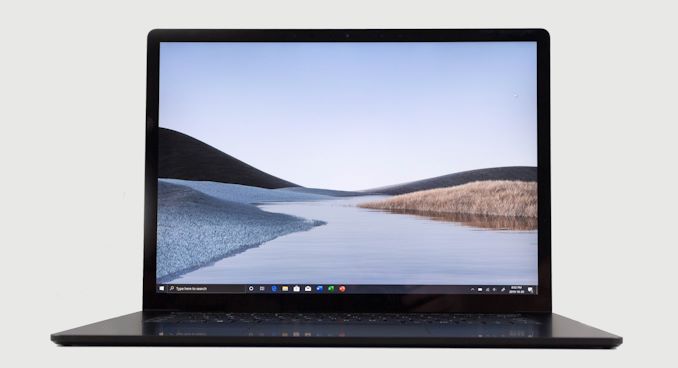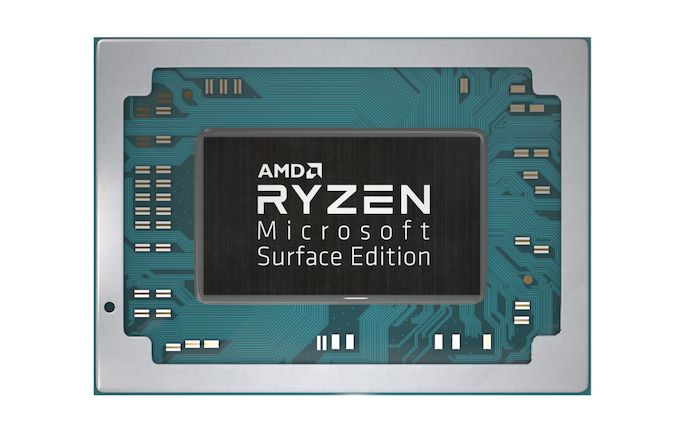The Microsoft Surface Laptop 3 Showdown: AMD's Ryzen Picasso vs. Intel's Ice Lake
by Brett Howse & Andrei Frumusanu on December 13, 2019 8:30 AM ESTFinal Words
Two laptops. Two platforms. It is rare to have a chance to see a manufacturer offer such equal footing to both AMD and Intel by outfitting a premium laptop with processors from both. It represents a rare opportunity to get to test the latest processors from AMD and Intel in a laptop in such an apples-to-apples fashion.
In the laptop space, design, cooling, and a manufacturers requirements can play a big part in how a particular chip performs, thanks to adjustable power level settings, surface temperature adjustments, and more. We have seen the lowest tier CPU outperform the highest tier CPU just by the virtue of a better cooling system, so to have processors from AMD and Intel, both of which launched in 2019, in the same chassis is a wonderful opportunity.
There aren’t too many ways to sugar coat the results of this showdown though. AMD’s Picasso platform, featuring its Zen+ cores and coupled with a Vega iGPU, has been a tremendous improvement for AMD. But Intel’s Ice Lake platform runs circles around it. Sunny Cove cores coupled with the larger Gen 11 graphics have proven to be too much to handle.
On the CPU side, no one should be too surprised by the results. We've already seen on the desktop that AMD’s Zen+ cores were competitive, but slightly slower than the previous Skylake platform; and the new Sunny Cove microarchitecture from Intel is a big step forward in terms of IPC for Intel. On purely CPU based tasks, Ice Lake really stretched its legs, and despite this being a 3.9 GHz chip, in single-threaded SPEC 2017, it managed to come very close to a 5.0 GHz Core i9-9900K with a massively higher TDP. Zen+ is outclassed here, and that showed in the benchmark results, and especially in the benchmark time. On our 8-thread SPEC 2017 run, the Ice Lake platform finished just a hair over two hours ahead of Picasso.
But things fare better for AMD on the GPU side of matters. Even though Intel has certainly closed the gap with Ice Lake's iGPU, AMD seems to continue to hold an advantage, especially on the 11 Compute Unit Ryzen Surface Edition processor found in the Surface Laptop 3. Intel has dedicated a lot more die area to the GPU and the results put them almost on equal footing with the Vega based GPU on Picasso. On the more complex GPU tasks, AMD tends to have a slight lead, and AMD’s low-level driver support also seems to benefit them on DirectX 12 based tasks. But, Ice Lake’s GPU is helped by the much quicker CPU it is coupled to, so depending on the specific test it can be even quicker.
Ice Lake does all of this with much better power efficiency as well. Overall battery life is quite a bit longer, and idle power draw is notably lower as well. Case in point: at minimum screen brightness, the Ice Lake system was pretty much only sipping power, drawing around 1.7 Watts, versus the 3.0 Watts for the AMD system.
It was fantastic to see AMD get a design win in a premium laptop this year, and the Surface Laptop 3 is going to turn a lot of heads over the next year. AMD has long needed a top-tier partner to really help its mobile efforts shine, and they now have that strong partner in Microsoft, with the two of them in a great place to make things even better for future designs. Overall AMD has made tremendous gains in their laptop chips with the Ryzen launch, but the company has been focusing more on the desktop and server space, especially with the Zen 2 launch earlier this year. For AMD, the move to Zen 2 in the laptop space can’t come soon enough, and will hopefully bring much closer power parity to Intel’s offerings as well.
Meanwhile for Intel, Ice Lake has been years in the making, and, after a long delay, it is finally here. After digging into the platform in-depth, it’s clear that Ice Lake is an incredibly strong offering from Intel. The CPU performance gains are significant, particularly because they were made in the face of a CPU frequency deficit. But the biggest gains were on the GPU side, where Intel’s Gen 11 GT2 in its full 64 Execution Unit configuration is likely the biggest single increase in GPU performance since they started integrating GPUs. It pulls very close to AMD’s Vega, closing the gap in performance to almost zero.
2019 has been a big year in the laptop space, with both Intel and AMD bringing new tools to the game. 2020 should be just as exciting, and if we’re lucky, we’ll get another chance to do this all over again.













174 Comments
View All Comments
Fataliity - Friday, December 13, 2019 - link
And I dont see a single page about temps? Is that because it runs at 90-100 C?extide - Friday, December 13, 2019 - link
There is an entire page of graphs with temps...dullard - Friday, December 13, 2019 - link
Exactly, but looking at Fatality's post above, it did not appear like Fatality wanted to see the actual truth. The CPU temps were not much different.https://images.anandtech.com/doci/15213/PCMark10.p...
Fataliity - Friday, December 13, 2019 - link
Every other website shows temps here.https://openbenchmarking.org/embed.php?i=1911040-H...
Over 90 celsius.
That single graph isnt a good comparison for temps. That's why its littered with 'frequency' and 'power'. to distort it.
Fataliity - Friday, December 13, 2019 - link
So it's not about "Not wanting to see the truth" It appears either anandtech's truth for temps is based on light workloads where the cpu isn't stressed at all, or possibly just wrong.Fataliity - Friday, December 13, 2019 - link
And this is supposed to be a "Showdown" between Ryzen and Intel. Not a "spotlight" or "sponsored" intel piece. So the way things were presented is very biased.I fully expect Intel's CPU to beat Ryzen, thats for sure. And graphics on higher than value setting, Ryzen scores about 5-10 fps higher. But on this review, It's intentionally skewed for Intel.
You should've just made a separate article for each if you were planning on favoring one company. And show their positives and negatives. Not focus on every possible positive of Intel and hide everything negative.
It's just not right, where people expect you to give a non-biased review to base their purchase off of.
Fataliity - Friday, December 13, 2019 - link
https://www.phoronix.com/scan.php?page=news_item&a...Link to article where graph is from.
Fataliity - Friday, December 13, 2019 - link
And how it actually performs in gaming, when your not using the IPC of Ice Lake to increase performance. The guy has plenty other videos if you care to watch.https://www.youtube.com/watch?v=B9FgYx2z0NY&t=...
maroon1 - Saturday, December 14, 2019 - link
PointlessThis is apu vs apu. It should be compared the way it is made
dullard - Friday, December 13, 2019 - link
1) Anandtech posted multiple graphs, I just linked one. Please actually read the article and look at all the data before posting here.2) Having additional data on a graph does not distort the temperatures that were measured.
3) You can't compare one laptop's temperature to another completely different laptop's temperature and have any conclusions that are valid (your link to a Dell XPS is not compariable to this article on a Microsoft Surface). This is because each laptop has completely different cooling systems, fan speeds, etc.
4) The temps were done doing things like multi-threadded Cinebench. If that is too light of a load for you, feel free to do your own test and post them here. https://images.anandtech.com/doci/15213/CinbenchR2...